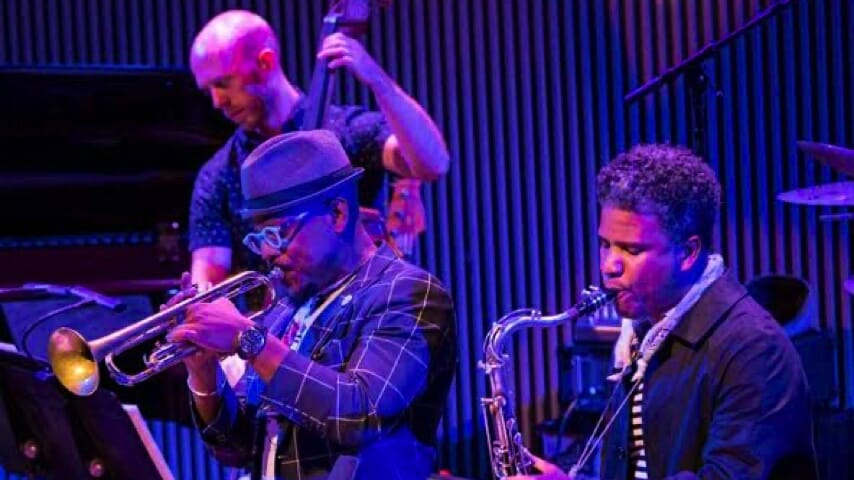Jazz Musicians Find a New Source of Standards: The Rock ‘n’ Roll Hall of Fame
The Curmudgeon
Sly Stone photo by Bob Cato/Sony Music Entertainment
There’s a reason Miles Davis recorded “My Funny Valentine” and John Coltrane “My Favorite Things.” Jazz musicians work via a strategy of theme-and-variation. They plant a melodic/rhythmic motif in the listener’s head, so that when they start playing variations on the theme, the listener can remember the original and appreciate how it’s being changed. This process works a whole lot better if the original tune is popular enough to already live in the listener’s head.
“My Funny Valentine” and “My Favorite Things” were that popular. The former song, written by Richard Rodgers and Lorenz Hart for the 1937 Broadway show Babes in Arms, was a song that most Americans knew, thanks to singers Frank Sinatra and Bing Crosby. Just as familiar was the latter tune from the 1959 Billboard chart-topping cast album for The Sound of Music, written by Rodgers and Oscar Hammerstein. So when Davis stretched out the first song with digressive lyricism or when Coltrane bombarded the second with sheets of sound, most listeners could remember the source material even as it was being reshaped.
If this process could happen with Rodgers’ songs, why couldn’t it happen with Sly Stone’s songs? Why didn’t Davis or Coltrane’s artistic heir Pharoah Sanders record Stone’s “Stand” or “You Can Make It If You Try” in the early ’70s? Why did we have to wait till the second decade of the new century to hear these songs tackled by major jazz artists? The SFJazz Collective recorded both songs for this year’s Live: SFJazz Center 2019 and Steven Bernstein’s Millennial Territory Orchestra did both on 2011’s MTO Plays Sly.
What took so long? It’s as if jazz musicians forgot why they were covering show tunes in the first place. It wasn’t because they were show tunes; it was because they were popular enough for listeners to know the melodies and to follow along as those themes were revised. When rock ’n’ roll replaced show tunes as America’s most popular music in the ’60s, jazz musicians should have replaced show tunes with rock ’n’ roll in their repertoire. But they didn’t.
There was a certain snobbery involved. Jazz musicians will tell you that show tunes have more interesting chord changes, and there’s a certain truth to that. But jazz players usually end up changing the chords anyway, so what difference does it make? And in retrospect, it’s clear that the most beautiful melodies and interesting changes of the ’60s and ’70s were coming not from Broadway but from rock ’n’ roll songwriters such as Stone, Paul McCartney, Stevie Wonder, Brian Wilson, Smokey Robinson, Joni Mitchell, Maurice White, Carole King, Jimi Hendrix and Donald Fagen. It was a missed opportunity.
But better late than never. Jazz musicians are now recovering from their former myopia and turning to the Rock and Roll Hall of Fame for material. Recent jazz albums have showcased not just the usual suspects (the Beatles, Steely Dan and Stevie Wonder) but also such welcome surprises as Sly Stone, Led Zeppelin and the Allman Brothers Band.

Matt Brewer, Etienne Charles and David Sanchez of the SFJazz Collective (courtesy of SFJazz Center)
The SFJazz Collective has been a pioneer in this effort. The octet is a group of jazz all-stars subsidized by the non-profit SFJazz Center, the West Coast equivalent of New York’s Jazz at Lincoln Center. The California group hit on the inspired notion of subsidizing a group of top jazz musicians to write new compositions and new arrangements of old standards and to rehearse them thoroughly before going into the studio and then on the road. Time for arranging and rehearsing is one of the rarest commodities in jazz, and the payoff is performances that are not just a parade of solos by under-prepared players but thoughtfully shaped pieces.
Each year the SFJazz Collective picks a composer and tasks each of its eight members to arrange one song by that composer and to write a new song in a similar style. The result is 16 pieces, enough for a double album and an evening of live music. In the early years, the group chose obvious composers such as Coltrane, Thelonious Monk, Wayne Shorter and Horace Silver, but in 2011 they chose Stevie Wonder.
That album began with trumpeter Avishai Cohen’s arrangement of “Sir Duke,” Wonder’s tribute to Ellington. It was a splendid example of how a jazz band can add something to a rock ’n’ roll classic without merely regurgitating it. In his 14-minute expansion of the tune, Cohen gives it both a classic hard-bop swing but also angular modern horn solos. Wonder’s catchy melodies surface often enough to keep the listener grounded and able to trace the wide tangents taken by the solos.
Just as good is tenor saxophonist Mark Turner’s arrangement of “Blame It on the Sun,” which deepens the ballad’s harmonies by massing the horns into dense, extended chords that set up the solos by the vibraphone and trombone. For “Superstition,” alto saxophonist Miguel Zenon varies the chorus melody a little bit each time it’s mentioned thereby realizing the song’s potential as never before.
-

-

-

-

-

-

-

-

-

-

-

-

-

-

-

-

-

-

-

-

-

-

-

-

-

-

-

-

-

-

-

-

-

-

-

-

-

-

-

-








































